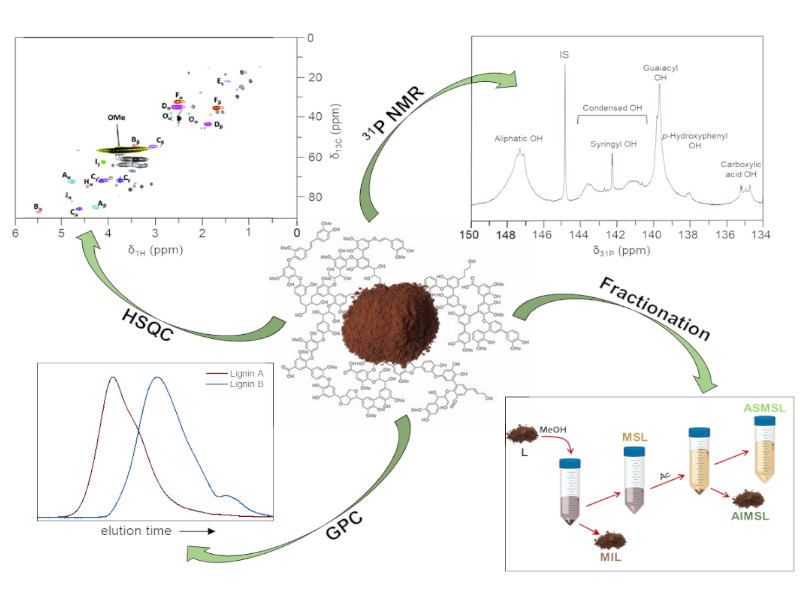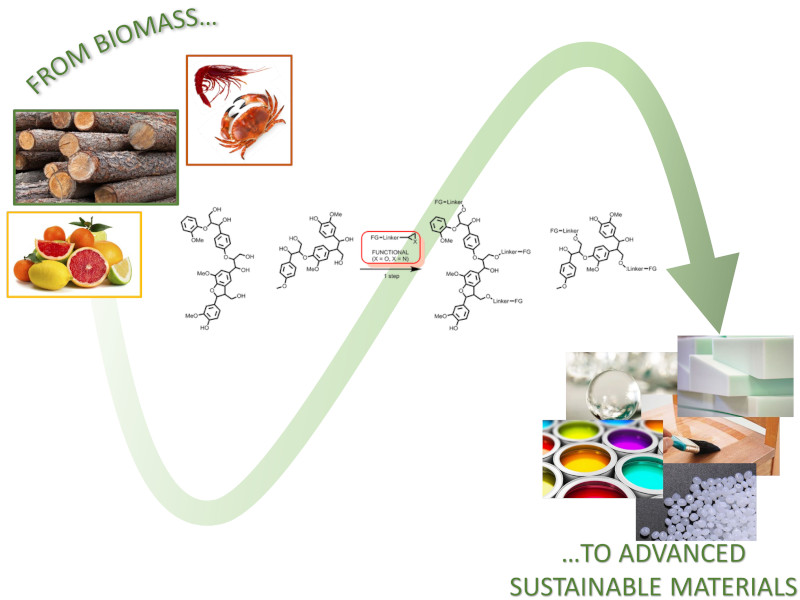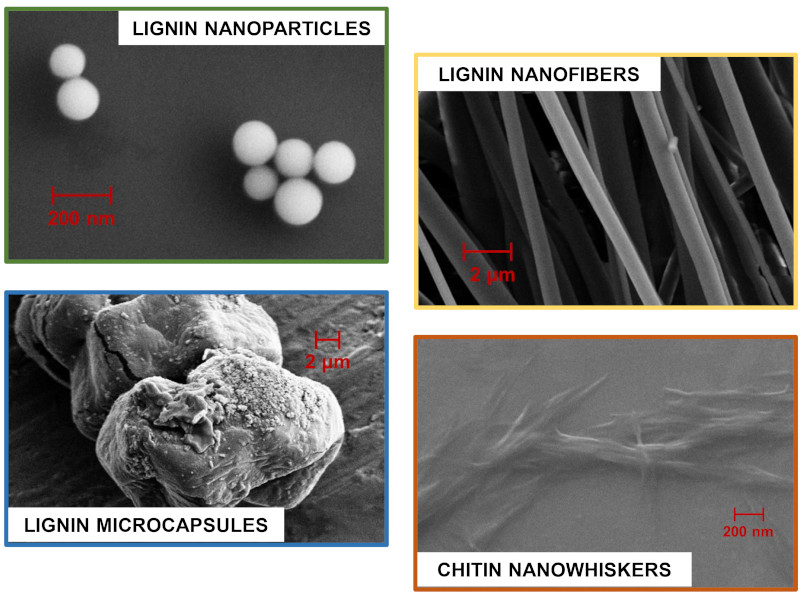Research
Research topics
Structural elucidation of natural polyphenols
This research activity focuses on the establishment of robust and reliable characterization protocols that can provide a comprehensive picture of the physicochemical features of natural polyphenols, whose intrinsic complexity hampers a full understanding of their structure and thus a thorough valorization.
By combining 2D NMR techniques with standardized quantitative 31P NMR, optimized GPC analyses, calorimetry and elemental analysis, also coupled with fractionation protocols, the necessary set of data that permit to achieve a rather complete structural idea of a given lignin or tannin are acquired.

For further reading on this research topic check:
- X. Meng, C. Crestini, H. Ben, N. Hao, Y. Pu, A.J. Ragauskas, D.S. Argyropoulos, Determination of hydroxyl groups in biorefinery resources via quantitative 31P NMR spectroscopy, Nature Protocols, 2019, 14(9), 2627–2647.
- C. Crestini, H. Lange, M. Sette, D.S. Argyropoulos, On the structure of softwood kraft lignin, Green Chemistry, 2017, 19(17), 4104–4121.
- H. Lange, F. Rulli, C. Crestini, Gel Permeation Chromatography in Determining Molecular Weights of Lignins: Critical Aspects Revisited for Improved Utility in the Development of Novel Materials, ACS Sustainable Chemistry and Engineering, 2016, 4(10), 5167–5180.
- C. Crestini, H. Lange, G. Bianchetti, Detailed Chemical Composition of Condensed Tannins via Quantitative 31P NMR and HSQC Analyses: Acacia catechu, Schinopsis balansae, and Acacia mearnsii, Journal of Natural Products, 2016, 79(9), 2287-2295.
Innovative high-performance thermoplastics and thermosets from renewable resources
This research activity deals with the design and development of innovative biobased materials to be employed either as commodities or high-performance specialties for a wide range of uses. More specifically, we work on active and biodegradable packaging materials, selective membranes for batteries, green coatings, and biocompatible polymers and hydrogels for biomedical purposes. By adopting ad hoc synthetic and post-functionalization approaches, we modulate the physicochemical characteristics of the prepared materials to satisfy the specific requests of the targeted application, with a focus on multi-functional and stimuli-responsive materials.

For further reading on this research topic check:
- F. Dominici, M. Gigli, I. Armentano, L. Genovese, F. Luzi, L. Torre, A. Munari, N. Lotti, Improving the flexibility and compostability of starch/poly(butylene cyclohexanedicarboxylate)-based blends, Carbohydrate Polymers, 2020, 246, 116631.
- P. Giannì, H. Lange, C. Crestini, Functionalized Organosolv Lignins Suitable for Modifications of Hard Surfaces, ACS Sustainable Chemistry and Engineering, 2020, 8(20), 7628–7638.
- S. Putzien, O. Fleischel, B. Bruchmann, A. Künkel, R. Mülhaupt, M. Gigli, Novel biobased amines, WO2017045987 A1.
- A. Duval, H. Lange, M. Lawoko, C. Crestini, Reversible crosslinking of lignin via the furan-maleimide Diels-Alder reaction, Green Chemistry, 2015, 17(11), 4991–5000.
High added-value micro- and nano-structures from (waste) biomass
Aiming at bridging nanotechnology with sustainable growth, we devote many research efforts on the study of biomass-derived micro- and nano-structures combining high performances with excellent bio- and eco-compatibility. Our goal is to achieve full control over the final characteristics of the prepared materials by properly selecting both the starting resources and the synthetic strategies. Our major interests include the preparation and characterization of (hybrid) microcapsules and nanoparticles for the entrapment and release of active compounds and electrospun (carbon) nanofibers and nanocomposites to be used for food/feed, environmental, energy and biomedical applications.

For further reading on this research topic check:
- S. Cailotto, M. Gigli, M. Bonini, F. Rigoni, C. Crestini, Sustainable Strategies in the Synthesis of Lignin Nanoparticles for the Release of Active Compounds: A Comparison, ChemSusChem, 2020, 13(17), 4759–4767
- M.H. Sipponen, H. Lange, C. Crestini, A. Henn, M. Österberg, Lignin for Nano- and Microscaled Carrier Systems: Applications, Trends, and Challenges, ChemSusChem, 2019, 12(10), 2039–2054
- M.H. Sipponen, H. Lange, M. Ago, C. Crestini, Understanding Lignin Aggregation Processes. A Case Study: Budesonide Entrapment and Stimuli Controlled Release from Lignin Nanoparticles, ACS Sustainable Chemistry and Engineering, 2018, 6(7), 9342–9351
- E.D. Bartzoka, H. Lange, G. Poce, C. Crestini, C., Stimuli-Responsive Tannin–FeIII Hybrid Microcapsules Demonstrated by the Active Release of an Anti-Tuberculosis Agent, ChemSusChem, 2018, 11(22), 3975–3991
Projects
Bacterial Enzymes and Bioprocesses for Lignin Valorization (B-LigZymes)
B-LigZymes is an international, interdisciplinary and intersectorial platform that directly addresses current limitations in lignin degradation by generating technological and economical solutions inspired by fundamental research. B-LigZymes provides a holistic view for the development of biocatalytic processes involved in the valorization of lignin.
Biofilm Management and Cleaning by Leveraging Fundamental Understanding of Biological, Chemical and Physical Combined Approaches (BIOCLEAN)
BIOCLEAN addresses the urgent need to create a sustainable training network across academia, industry and the healthcare sector which will fill the gap in Europe and beyond to produce highly skilled multi-disciplinary young scientists competent in chemistry, engineering and experimental wet lab biology. BIOCLEAN will deliver this network of young scientists who can apply their proven skill sets gained during the project life time to solve industrial and healthcare sector real life biofilm management challenges.
BIO-CLEAN project (GA n° 722871) - H2020-EU.1.3.1. MSCA-ITN-2016 - Innovative Training Networks
New Bio-Inspired Processes and Products from Renewable Feedstocks (BIOMIMETIC)
The BIO-MIMETIC project will generate a new class of bio-inspired polymers via extraction of natural compounds from renewable resources.
These polymers with novel properties will be produced through a new biological transformation route, involving environmentally friendly enzymatic processes, inspired by polymerisation processes in nature.
The novel BIO-MIMETIC process-route will use renewable resources.New enzymes will be developed to transform bio-mass into bio-based polymers that can be conjugated or cross-linked into novel polymeric structures for consumer products.
BIO-MIMETIC project (GA n° 282945) FP7 ENV.2011.3.1.9-1 [Eco-innovation]
Bioinspired tool for surface water monitoring based on Algal Polyphenol Production (BlueAPP)
BlueAPP aims at providing an innovative surface water monitoring system based on algae. Environmental stress factors triggering the algal production of polyphenols will be used as metal complex builders for on spot-spectrophotometric and off-site electrochemical analysis.
Framework of Scientific and Technological Cooperation between Italy and Israel (Scientific track 2019)
Second generation bioethanol from italian biomass: feedstock quality, conversion efficiency and waste use optimization (EFFBIOETA2)
The project aims at generating new knowledge in the field of second-generation bioethanol from biomass waste produced by italian wine industry or short life-cycle woody crops.
